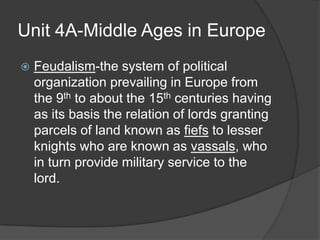
Unit 4 a middle ages in europe notes and vocab
- 1. Unit 4A-Middle Ages in Europe Feudalism-the system of political organization prevailing in Europe from the 9th to about the 15th centuries having as its basis the relation of lords granting parcels of land known as fiefs to lesser knights who are known as vassals, who in turn provide military service to the lord.
- 2. Feudalism Reciprocal military obligations between members of the warrior nobility in Medieval Europe
- 3. Feudalism Characteristics-Lords grant parcels of land known as fiefs to lesser knights who are known as vassals, who in turn, provide military service to the lord. Chivalry and fealty between the lord and vassal Contributing Factors-Fall of the Roman Empire leaves a gap in protection and services to the people, invaders overrun communities, people turn to their local lord for protection
- 4. Unit 4A-Middle Ages in Europe Manorialism-smallest economic social unit revolving around an estate, controlled by a lord, who gives land and protection to his serfs, who in turn give him their services.
- 5. Manorialism Land=Wealth!!! Characteristics-Manors were self-sufficient where serfs raised and produced nearly everything needed for that community. The open-field system allowed several families of serfs to farm strips of the same parcel of land. Living conditions were generally harsh. Contributing Factors-Model of villas in the Roman Empire used to manage rural economies; decline in overland and sea trade after the fall of Rome as well as threats from invaders promoted the self-sufficiency of the manor.
- 6. Unit 4A-Middle Ages in Europe Schism-a formal division in or separation from a church or religious body Great Schism- 1054-divides the Eastern and Western Churches into Roman Catholic and the Orthodox Church
- 7. Unit 4A-Middle Ages in Europe Hundred Years’ War-a series of wars fought between England and France from 1337-1453…Joan of Arc.
- 8. The Spread of Christianity During the Middle Ages- “The Age of Faith” Church develops in power during the Middle Ages-THE AUTHORITY! People look to the Church for security, stability, and protection in times of frequent wars Shared beliefs bond the people of Medieval Europe 1054-Great Schism-divides the Eastern and Western Churches into Roman Catholic Church and the Orthodox Church
- 9. Christianity in Medieval Europe- “The Age of Faith” Missionaries spread Christianity Authority in Medieval Europe based on the Church Charlemagne crowned emperor by Pope Leo III, which shows the close connection between Church and state Church creates a system of justice, canon law, to regulate peoples’ conduct
- 10. Religious Influence-The Medieval Church Unifying force Shared beliefs and rituals Sense of security and community At the local level, Church was the religious AND social center. People met there for service, social gatherings, and festive celebrations Performed social services such as caring for the sick and the poor-operated most hospitals in Medieval Europe
- 11. Thomas Aquinas Catholic philosopher and theologian of the Middle Ages-13th Century “Summa Theologica” AKA “Summary of Theology Establishment of universities-emerging from the Dark Ages and “rediscovering” classical thought (especially the Greeks!) It had been preserved by the Byzantine and Islamic world Tried to reconcile Faith and Reason Known as Scholasticism-set the stage for the Renaissance and Reformation
- 12. Roman Catholicism vs. Eastern Orthodoxy Pope has authority over Patriarch and other all other bishops, kings, bishops lead the church and emperors as a collective group Services conducted in Services conducted in Latin Greek or local languages Priests cannot marry Priests may marry Divorce is not permitted Divorce is allowed under certain circumstances Roman Catholicism- Eastern Orthodox- Western Europe Byzantine Empire
- 13. How did the development of Christianity act as a unifying social and political factor in Medieval Europe and the Byzantine Empire? Missionaries Constantine relocated the Political authority based on capital of the Eastern Roman Empire-Constantinople the Church Justinian constructs Hagia Charlemagne crowned Sophia and other churches emperor by the Pope throughout the Byzantine Shared beliefs act as a Empire to show close bond connection between Church and state Stability and security Missionaries St. Cyril and St. “Age of Faith” Methodius-Cyrillic language System of justice-canon and Christianization of the law Slavs (Russia) Medieval Europe Byzantine Empire